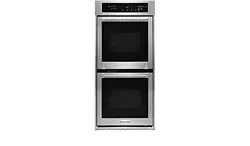Documents: Go to download!
User Manual
- User Manual - (English, French, Spanish)
- Dimension Guide - (English)
- Warranty - (English)
- Installation Instruction - (English)
- FEATURE GUIDE
- OVEN USE
- OVEN CARE
- PROBLEM SOLVER
Table of contents
User manual Oven
FEATURE GUIDE
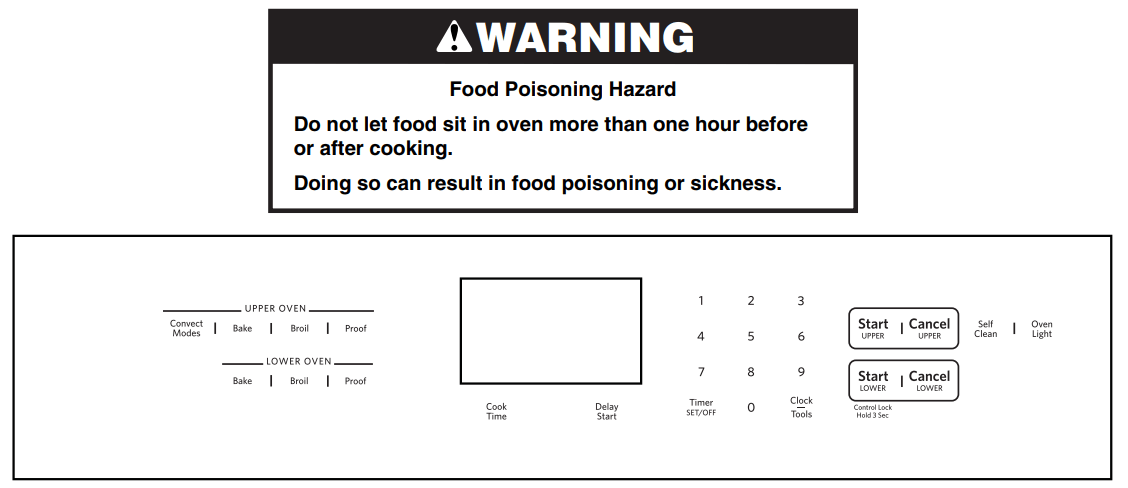
KEYPAD | FEATURE | INSTRUCTIONS |
CLOCK/TOOLS | Clock | This clock can use a 12- or 24-hour cycle. See “Electronic Oven Controls” section. 1. Press CLOCK/TOOLS until “Clock” is displayed. 2. Press the number keypads to set the time of day. 3. Press START. |
CLOCK/TOOLS | Oven use functions | Enables you to personalize the audible tones and oven operation to suit your needs. See the “Oven Use” section. |
OVEN LIGHT | Oven cavity light | While the oven door(s) are closed, press OVEN LIGHT to turn the lights on and off. The oven lights will come on when an oven door is opened. |
TIMER SET/OFF | Oven timer | The Timer can be set in hours or minutes up to 9 hours and 59 minutes. 1. Press TIMER SET/OFF. 2. Press the number keypads to set the length of time in hr-min. Leading zeros do not have to be entered. For example, for 2 minutes, enter “2.” 3. Press TIMER SET/OFF to begin the countdown. If enabled, timer tone(s) will sound at the end of countdown. 4. Press TIMER SET/OFF to cancel the Timer and return to the time of day. Do not press the Cancel keypad because the oven will turn off. |
START | Cooking start | The Start keypad begins any oven function. If Start is not pressed within 2 minutes after pressing a keypad, the function is canceled and the time of day is displayed. |
CANCEL | Oven function | The Cancel keypad stops any oven function except the Clock, Timer and Control Lock in the selected oven. |
BAKE | Baking and roasting | 1. Press BAKE for the desired oven. 2. Press the number keypads to set the desired temperature. If the temperature entered is not in the range of the temperatures allowed, the minimum or maximum allowed temperature will be displayed. Enter a temperature in the allowable range. 3. Press START for the selected oven. 4. To change the temperature when one oven is in use, repeat steps 2 and 3. To change the temperature when two ovens are in use, press “1” for the upper oven or press “2” for the lower oven, and then repeat steps 2 and 3. 5. Press CANCEL for the selected oven when finished. |
BROIL | Broiling | 1. Press BROIL for the desired oven. 2. Press the number keypads to set the desired temperature. If the temperature entered is not in the range of the temperatures allowed, the minimum or maximum allowed temperature will be displayed. Enter a temperature in the allowable range. 3. Press START for the selected oven, and then allow the oven to preheat for 2 minutes. 4. Position the cookware in the oven and close the door. 5. To change the temperature when one oven is in use, repeat steps 2 and 3. To change the temperature when two ovens are in use, press “1” for the upper oven or press “2” for the lower oven, and then repeat steps 2 and 3. 6. Press CANCEL for the selected oven when finished. |
CONVECT MODES (Single or upper oven only) | Convection cooking | 1. Press CONVECT MODES until the desired mode is displayed. 2. Press START for the desired oven. 3. Press the number keypads to set the desired temperature. If the temperature entered is not in the range of the temperatures allowed, the minimum or maximum allowed temperature will be displayed. Enter a temperature in the allowable range. 4. Press START for the selected oven. 5. To change the temperature, repeat steps 3 and 4. 6. Press CANCEL for the selected oven when finished. |
PROOF | Proofing bread | 1. Press PROOF until the desired proof is displayed (“Standard Proof” or “Rapid Proof”). NOTE: “Rapid” operates at a slightly higher temperature for second rise of formed dough. 2. Press START for the selected oven. Let the dough rise until nearly doubled in size. Proofing time may vary depending on dough type and quantity. 3. Press CANCEL for the selected oven when finished proofing. Refer to the “Proofing Bread” section for more information. |
DELAY START | Delayed start | The Delay Start keypad is used to enter the starting time for an oven function with a delayed start. Delay Start should not be used for foods such as breads and cakes because they may not bake properly. To set a Timed Cook or a Delayed Timed Cook, see the “Cook Time” section. |
COOK TIME | Timed cooking | Cook Time allows the oven to be set to turn on at a certain time of day, cook for a set length of time, and/or shut off automatically. To set a Timed Cook or a Delayed Timed Cook, see the “Cook Time” section. |
SELF CLEAN | Self-clean cycle | See the “Self-Clean Cycle” section. |
START/START LOWER CONTROL LOCK hold 3 sec. | Oven control lockout | 1. Check that the ovens and timers are off. 2. Press and hold START or START LOWER for 3 seconds. 3. If enabled, a tone will sound, and “CONTROL LOCKED” will be displayed. 4. Repeat to unlock. No keypads will function with the controls locked. |
OVEN USE
Odors and smoke are normal when the oven is used the first few times or when it is heavily soiled.
IMPORTANT: The health of some birds is extremely sensitive to the fumes given off. Exposure to the fumes may result in death to certain birds. Always move birds to another closed and wellventilated room.
Electronic Oven Controls
Control Display
The display will light up when first powered up or after a power loss. When oven is not in use, the time of day is displayed.
Tones
Tones are audible signals, indicating the following:
One Tone
■ Valid keypad press.
■ Oven is preheated (long tone).
■ Kitchen timer (long tone with reminder tone every 60 seconds).
■ Function has been entered.
Three Tones
■ Invalid keypad press.
Four Tones
■ End of cycle (with reminder tone every 60 seconds).
Use the Clock/Tools keypad to change the tone settings.
Tools
Many features of the oven control can be adjusted to meet your personal needs. These changes are made using the Clock/Tools keypad.
Use the Clock/Tools keypad to scroll through the features that can be changed. Each press of the Clock/Tools keypad will advance the display to the next setting. After selecting the feature to be changed, the control will prompt you for the required input. Details of all of the feature changes are explained in the following sections.
Press CANCEL to exit Tools.
Fahrenheit and Celsius
The temperature is preset to Fahrenheit, but can be changed to Celsius.
1. Press CLOCK/TOOLS until “TEMP UNIT” is displayed.
2. The current setting will be displayed.
3. Press the “1” keypad to adjust the setting.
4. Press CANCEL to exit and display the time of day.
Audible Tones Disable
Turns off all tones, including the end of cycle tone and key press tones.
1. Press CLOCK/TOOLS until “SOUND” is displayed.
2. The current setting will be displayed.
3. Press the “1” keypad to adjust the setting.
4. Press CANCEL to exit and display the time of day.
Sound Volume
Sets the pitch of the tone to either high or low.
1. Press CLOCK/TOOLS until “SOUND VOLUME” is displayed.
2. The current setting will be displayed.
3. Press the “1” keypad to adjust the setting.
4. Press CANCEL to exit and display the time of day.
End of Cycle Tone
Activates or turns off the tones that sound at the end of a cycle.
1. Press CLOCK/TOOLS until “END TONE” is displayed.
2. The current setting will be displayed.
3. Press the “1” keypad to adjust the setting.
4. Press CANCEL to exit and display the time of day.
Key Press Tones
Activates or turns off the tones when a keypad is pressed.
1. Press CLOCK/TOOLS until “KEYPRESS TONE” is displayed.
2. The current setting will be displayed.
3. Press the “1” keypad to adjust the setting.
4. Press CANCEL to exit and display the time of day.
Reminder Tones Disable
Turns off the short repeating tone that sounds every 1 minute after the end of cycle tones.
1. Press CLOCK/TOOLS until “REMINDER TONE” is displayed.
2. The current setting will be displayed.
3. Press the “1” keypad to adjust the setting.
4. Press CANCEL to exit and display the time of day.
12/24 Hour Clock
1. Press CLOCK/TOOLS until “12/24 HOUR” is displayed.
2. The current setting will be displayed.
3. Press the “1” keypad to adjust the setting.
4. Press CANCEL to exit and display the time of day.
Demo Mode
IMPORTANT: This feature is intended for use on the sales floor with 120V power connection and permits the control features to be demonstrated without heating elements turning on. If this feature is activated, the oven will not work.
1. Press CLOCK/TOOLS until “DEMO MODE” is displayed.
2. The current setting will be displayed.
3. Press the “1” keypad to adjust the setting.
4. Press CANCEL to exit and display the time of day.
12-Hour Shutoff
The oven control is set to automatically shut off the oven 12 hours after the oven initiates a cook or clean function. This will not interfere with any timed or delay cook functions.
1. Press CLOCK/TOOLS until “12 HR AUTO OFF” is displayed.
2. The current setting will be displayed.
3. Press the “1” keypad to adjust the setting.
4. Press CANCEL to exit and display the time of day.
Languages - Scrolling Display Text
Language options are English, Spanish and French.
1. Press CLOCK/TOOLS until “LANGUAGE” is displayed.
2. The current setting will be displayed.
3. Press the number keypad as instructed by the scrolling text to select the new language.
4. Press CANCEL to exit and display the time of day.
Oven Temperature Offset Control
IMPORTANT: Do not use a thermometer to measure oven temperature. Elements will cycle on and off as needed to provide consistent temperature, but they may run slightly hot or cool at any point in time due to this cycling. Most thermometers are slow to react to temperature change and will not provide an accurate reading due to this cycling.
The oven provides accurate temperatures; however, it may cook faster or slower than your previous oven, so the temperature can be adjusted to personalize it for your cooking needs. It can be changed to Fahrenheit or Celsius.
To Adjust Oven Temperature:
1. Press CLOCK/TOOLS until “TEMP CALIB” is displayed.
2. The current setting will be displayed. For double ovens only: Press the “1” keypad to toggle between the upper and lower ovens.
3. Press START for the selected oven to select the choice displayed in Step 2. Wait several seconds for the display to change or press START for the selected oven, and then continue with Step 4.
4. Press the “3” keypad to increase the temperature in 5°F (3°C) increments, or press the “6” keypad to decrease the temperature in 5°F (3°C) increments. The range is from -30°F to +30°F (-18°C to +18°C).
5. Press START.
6. Press CANCEL for the selected oven to exit and display the time of day.
Sabbath Mode
The Sabbath Mode sets the oven to remain on in a bake setting until turned off.
When the Sabbath Mode is set, only the Bake cycle will operate. All other cooking and cleaning cycles are disabled. No tones will sound, and the displays will not indicate temperature changes. When the oven door is opened or closed, the oven light will not turn on or off, and the heating elements will not turn on or off immediately.
To Enable Sabbath Mode Capability (One Time Only):
1. Press CLOCK/TOOLS until “SABBATH” is displayed.
2. Press the “1” keypad. Sabbath Mode can be activated for baking.
3. Press CANCEL to save the setting and exit to display the time of day.
NOTE: To disable the Sabbath Mode, repeat steps 1 through 3 to change the status from “SABBATH ON” to “SABBATH OFF.”
To Activate Sabbath Mode:
1. Press BAKE for the desired oven.
2. Press the number keypads to set the desired temperature. If the temperature entered is not in the range of the temperatures allowed, the minimum or maximum allowed temperature will be displayed. Enter a temperature in the allowable range.
3. Press START for the selected oven.
For timed cooking in Sabbath Mode, press COOK TIME, and then press the number keypads to set the desired cook time. Press START for the selected oven.
4. (Optional) If Sabbath Mode is to be used for both ovens, repeat steps 1 through 3 for the second oven.
5. Press CLOCK/TOOLS. Three tones will sound. Then press “7.” “SAb” will appear in the display.
To Adjust Temperature (when Sabbath Mode is running in only one oven):
1. Press the number keypad as instructed by the scrolling text to select the new temperature.
NOTE: The temperature adjustment will not appear on the display, and no tones will sound. The scrolling text will be shown on the display as it was before the keypad was pressed.
2. Press START for the selected oven.
To Adjust Temperature (when Sabbath Mode is running in both ovens):
1. Press BAKE for the desired oven.
2. Press the number keypad as instructed by the scrolling text to select the new temperature.
NOTE: The temperature adjustment will not appear on the display, and no tones will sound. The scrolling text will be shown on the display as it was before the keypad was pressed.
3. Press START for the selected oven.
To Deactivate Sabbath Mode:
Press CLOCK/TOOLS, and then press “7” to return to regular baking, or press CANCEL for the desired oven to turn off the oven(s).
Aluminum Foil
IMPORTANT: To avoid permanent damage to the oven bottom finish, do not line the oven bottom with any type of foil or liner. For best cooking results, do not cover entire oven rack with foil because air must be able to move freely. Positioning Racks and
Positioning Racks and Bakeware
IMPORTANT: To avoid permanent damage to the porcelain finish, do not place food or bakeware directly on the oven door or bottom.
Racks
■ Position racks before turning on the oven.
■ Do not position racks with bakeware on them.
■ Make sure racks are level.
■ Place food so it will not rise into the broil element. Allow at least V2" (1.3 cm) between pans and the broil element.
To move a rack, pull it out to the stop position, raise the front edge, and then lift it out. Use the following illustrations and charts as a guide for positioning racks.
Rack Positions

Broiling

Baking

Baking Layer Cakes on 1 Rack
Place the cakes on the rack as shown.
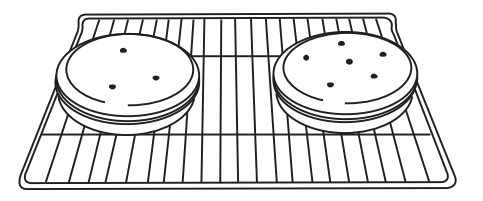
Multiple Rack Cooking
2-rack: Use rack positions 2 and 4 for regular baking.
2-rack (convection only): Use rack positions 2 and 4 for convection baking.
Baking Layer Cakes on 2 Racks
For best results when baking cakes on 2 racks, use rack positions 2 and 4 with the Convection Bake function. Place the cakes on the racks as shown.
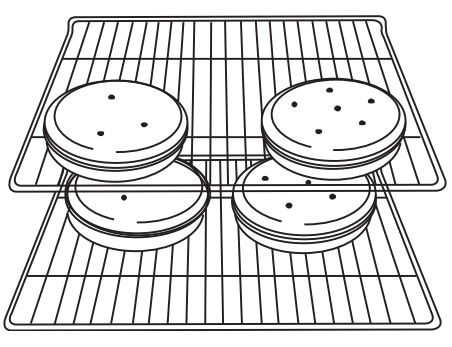
Baking Cookies on 2 Racks
For best results when baking cookies on 2 racks, use rack positions 2 and 4 with the Convection Bake function.
Baking Stone
The Baking Stone is ideal for baking and reheating. Because the Baking Stone absorbs excess moisture, heat is concentrated for crispier pizza and more thorough baking of bread and cookies. It is oven safe to 550°F (288°C).
For Best Results:
■ Place Baking Stone centered on Rack 1.
■ Use a regular bake cycle.
■ Avoid clustering food on the Baking Stone.
■ You may use parchment paper with the Baking Stone to aid in removing food.
■ For best bottom browning, preheat oven with Baking Stone prior to use. Preheating with the Baking Stone may take longer than usual.
■ Thaw frozen foods in the refrigerator prior to baking. Refrigerated food can be placed directly in the oven after it is preheated.
■ Not intended for multi-rack baking.
■ Follow recipe temperature and baking time. Short baking times may need an extra 1-2 minutes.
Tips for Use:
- Always use a heat-resistant oven mitt or pad when handling.
- Seasoning is not needed.
- The stone will discolor with age. This will enhance the performance.
- Avoid placing any other pan or rack on top of the Baking Stone.
- Baking Stone is metal utensil safe.
- When placing Baking Stone on a surface, first cover surface with a sturdy material to avoid scratches.
To Avoid Damage to Your Stone:
- Avoid extreme temperature changes.
- Do not use Baking Stone if damaged or chipped.
- Do not use on a direct heat source or under a broiler.
- Do not touch the closed oven door or sides of oven with Baking
Stone. - Avoid bumping or dropping the Baking Stone, which can break.
Oven Vent(s)
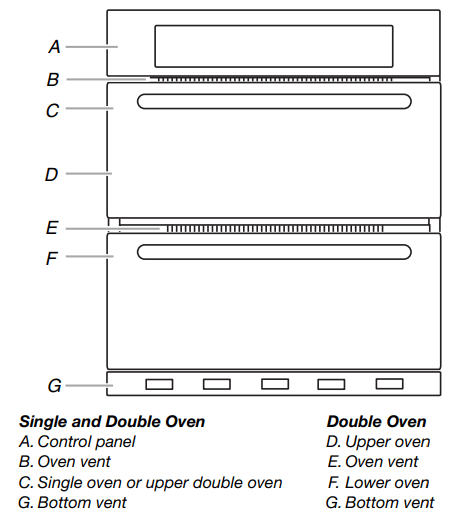
The oven vent(s) should not be blocked or covered since they allow the inlet of fresh air into the cooling system. Also, the bottom vent should not be blocked or covered since it allows the inlet of fresh air into the cooling system and the outlet of hot air from the cooling system. Blocking or covering vents will cause poor air circulation, affecting cooking, cleaning and cooling results.
Baking and Roasting
Preheating
When beginning a Bake, Convect Bake or Convect Roast cycle, the oven will begin preheating after Start is pressed. The oven will take approximately 13 to 19 minutes to reach 350°F (177°C) with all of the oven racks provided with your oven inside the oven cavity. Higher temperatures will take longer to preheat. The preheat cycle rapidly increases the oven temperature. The actual oven temperature will go above your set temperature to offset the heat lost when your oven door is opened to insert food. This ensures that when you place your food in the oven, the oven will begin at the proper temperature. Insert your food when the preheat tone sounds. Do not open the door during preheat before the tone sounds.
Oven Temperature
While in use, the oven elements will cycle on and off as needed to maintain a consistent temperature, but they may run slightly hot or cool at any point in time due to this cycling. Opening the oven door while in use will release the hot air and cool the oven which could impact the cooking time and performance. It is recommended to use the oven light to monitor cooking progress.
NOTE: On models with convection, the convection fan may run in the non-convection bake mode to improve oven performance.
Before baking and roasting, position racks according to the “Positioning Racks and Bakeware” section. When roasting, it is not necessary to wait for the oven preheat cycle to end before putting food in unless it is recommended in the recipe.
Broiling
When broiling, preheat the oven for 2 minutes before putting food in unless recommended otherwise in the recipe. Position food on grid in a broiler pan, and then place it in the center of the oven rack. Close the oven door to ensure proper broiling temperature.
NOTE: Odors and smoke are normal the first few times the oven is used or if the oven is heavily soiled.
Changing the temperature when broiling allows more precise control when cooking. The lower the broil setting, the slower the cooking. Thicker cuts and unevenly shaped pieces of meat, fish and poultry may cook better at lower broil settings. Place the food in the upper or lower oven. Refer to the “Positioning Racks and Bakeware” section for more information.
On lower settings, the broil element will cycle on and off to maintain the proper temperature.
■ For best results, use a broiler pan and grid. It is designed to drain juices and help avoid spatter and smoke.
If you would like to purchase a broiler pan, one may be ordered. Please refer to the “Accessories” section for more information.
Convection Cooking - Upper Oven Only
During convection cooking, the fan provides hot air circulation throughout the oven. The movement of heated air around the food can help to speed up cooking by penetrating the cooler outer surfaces. Food cooks more evenly, browning and crisping outer surfaces while sealing moisture inside.
During the Convect function, the ring element, bake and broil elements, and the fan operate to heat the oven cavity. If the oven door is opened during convection cooking or preheating, the fan turns off immediately and the element(s) will turn off after 30 seconds. Once the door is closed, the element(s) will turn back on.
NOTE: It is normal for the convection fan to run during nonconvection cycles as well as during preheat.
■ It is important not to cover foods so that surface areas remain exposed to the circulating air, allowing browning and crisping.
■ Keep heat loss to a minimum by only opening the oven door when necessary. It is recommended to use the oven light to monitor cooking progress.
■ Choose cookie sheets without sides and roasting pans with lower sides to allow air to move freely around the food.
■ Test baked goods for doneness a few minutes before the minimum cooking time with a method such as a toothpick.
■ Use a meat thermometer to determine the doneness of meats and poultry. Check the temperature of pork and poultry in 2 or 3 different places, including the thickest part.
■ Before convection cooking, position the rack(s) according to the “Positioning Racks and Bakeware” section.
■ When using more than one rack, position bakeware/cookware on the racks to allow movement of the fan circulated air around the food. See the “Positioning Racks and Bakeware” section.
■ If the oven is full, extra cooking time may be needed.
■ For optimal cooking results, do not cover food.
■ When roasting poultry and meat, use a broiler pan and grid. It is not necessary to wait for the oven to preheat, unless recommended in the recipe.
To order a broiler pan, see the “Assistance or Service” section.
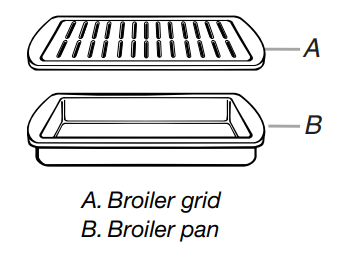
OVEN CARE
Self-Cleaning Cycle
IMPORTANT: The health of some birds is extremely sensitive to the fumes given off during the Self-Cleaning cycle. Exposure to the fumes may result in death to certain birds. Always move birds to another closed and well-ventilated room.
Keep the kitchen well-ventilated during the Self-Cleaning cycle to help get rid of heat, odors and smoke.
Do not block the oven vent(s) during the Self-Cleaning cycle.
Air must be able to move freely. Depending on your model, see “Oven Vent” or “Oven Vents” section.
Do not clean, rub, damage or move the oven door gasket.
Prepare Oven:
■ Remove the broiler pan, grid, cookware and bakeware, all cooking utensils, oven racks and aluminum foil and, on some models, the temperature probe from the oven.
■ Use a damp cloth to clean inside door edge and the 11/2" (38 mm) area around the inside oven cavity frame, being certain not to move or bend the gasket.
■ Wipe out any loose soil to reduce smoke and avoid damage. At high temperatures, foods react with porcelain. Staining, etching, pitting or faint white spots can result. This will not affect cooking performance.
IMPORTANT:
- Oven temperature must be below 500°F (260°C) to program a clean cycle.
- For double ovens only: Only 1 oven can be cleaned at a time.
- For double ovens only: Both oven doors will lock when either oven is running the Self-Cleaning cycle.
How the Cycle Works
IMPORTANT: The heating and cooling of porcelain on steel in the oven may result in discoloring, loss of gloss, hairline cracks and popping sounds.
The Self-Cleaning cycle uses very high temperatures, burning soil to a powdery ash.
Once the oven has completely cooled, remove ash with a damp cloth. To avoid breaking the glass, do not apply a cool damp cloth to the inner door glass before it has completely cooled.
The oven light will not work during the Self-Cleaning cycle.
To stop the Self-Cleaning cycle at anytime, press CANCEL for the selected oven. If the temperature is too high, the oven doors will remain locked.
When “LOCK” shows in the display, the doors of the oven cannot be opened. To avoid damage to the doors, do not force the doors open when “LOCK” is displayed.
Before self-cleaning, make sure the doors are completely closed or the doors will not lock and the Self-Cleaning cycle will not begin.
NOTE: 12 hours must pass before the next Self-Clean can begin, and for double ovens only: only one oven can use the Self-Clean cycle at a time
The oven is preset for a 4-hour clean cycle; however, the time can be changed. Suggested clean times are 3 hours for light soil and between 4 hours and 5 hours for average to heavy soil.
Use the following chart as a guide to determine the desired cleaning level.

To Self-Clean:
1. Close the oven doors, and then press SELF CLEAN.
2. For double ovens only: Press the number “1” or “2” keypad to select the desired oven to clean.
3. Choose the clean level desired by pressing the appropriate number keypad as instructed by the scrolling text.
4. Press START for the selected oven.
The oven doors will automatically lock.
When the Self-Clean cycle is complete and the oven cools, the oven doors will unlock.
5. When the oven is completely cooled, remove ash with a damp cloth.
To Delay Start Self-Clean:
1. Close the oven doors, and then press DELAY START.
2. For double ovens only: Press the number “1” or “2” keypad to select the desired oven to clean.
3. Press the number keypads to enter the desired amount of time by which you want to delay the start.
4. Press SELF CLEAN.
5. Choose the clean level desired by pressing the appropriate number keypad as instructed by the scrolling text.
6. Press START for the selected oven.
The oven doors will automatically lock after the Delay Start countdown.
When the Self-Clean cycle is complete and the oven cools, the oven doors will unlock.
7. When the oven is completely cooled, remove ash with a damp cloth.
General Cleaning
Soap, water and a soft cloth or sponge are suggested first unless otherwise noted.
EXTERIOR PORCELAIN ENAMEL SURFACES (on some models)
Food spills containing acids, such as vinegar and tomato, should be cleaned as soon as the entire oven is cool. These spills may affect the finish.
Cleaning Method:
■ Glass cleaner, mild liquid cleaner or nonabrasive scrubbing pad:
Gently clean around the model/serial/rating plate because scrubbing may remove numbers.
■ affresh® Kitchen and Appliance Cleaner Part Number W10355010 (not included):
See the “Accessories” section for more information.
STAINLESS STEEL (on some models)
NOTE: To avoid damage to stainless steel surfaces, do not use soap-filled scouring pads, abrasive cleaners, steel-wool pads, gritty washcloths or abrasive paper towels. Damage may occur to stainless steel surfaces, even with one-time or limited use.
Cleaning Method:
Rub in direction of grain to avoid damaging.
■ affresh® Stainless Steel Cleaner Part Number W10355016: See the “Accessories” section for more information.
METALLIC PAINT (on some models)
Do not use abrasive cleaners, cleaners with bleach, rust removers, ammonia or sodium hydroxide (lye) because paint surface may stain.
CONTROL PANEL AND OVEN DOOR EXTERIOR
To avoid damage to the control panel, do not use abrasive cleaners, steel-wool pads, gritty washcloths or abrasive paper towels.
Cleaning Method:
■ Glass cleaner and soft cloth or sponge:nApply glass cleaner to soft cloth or sponge, not directly on panel.
■ affresh® Kitchen and Appliance Cleaner Part Number W10355010 (not included): See the “Accessories” section for more information.
OVEN RACKS
Cleaning Method:
■ Steel-wool pad.
■ For racks that have discolored and are harder to slide, a light coating of vegetable oil applied to the rack guides will help them slide.
BAKING STONE
Cleaning Method:
■ Before cleaning, allow Baking Stone to cool. Hand wash and rinse with warm water.
■ Use a plastic scraper to remove baked-on foods.
■ Do not use soap or detergent.
■ Do not soak or clean in a dishwasher.
OVEN CAVITY
Do not use oven cleaners.
Food spills should be cleaned after the oven cools. At high temperatures, foods react with porcelain and staining, etching, pitting or faint white spots can result.
Cleaning Method:
■ Self-Cleaning cycle: See “Self-Cleaning Cycle” first.
Oven Lights
The oven lights are standard 40-watt appliance bulbs. Before replacing, make sure the oven is cool and the controls are turned Off.
To Replace:
1. Disconnect power.
2. Turn the glass bulb cover in the back of the oven counterclockwise to remove.
3. Turn bulb counterclockwise to remove from socket.
4. Replace bulb, and then bulb cover by turning clockwise.
5. Reconnect power.
PROBLEM SOLVER
PROBLEM | POSSIBLE CAUSES AND/OR SOLUTIONS |
Nothing will operate | Oven isn’t wired properly - See the Installation Instructions. Household fuse is blown, or a circuit breaker is tripped - Replace the fuse or reset the circuit breaker. If the problem continues, call an electrician. The control displays an F9 or F9 E0 error code - The electrical outlet in the home may be miswired. Contact a qualified electrician to verify the electrical supply. |
Oven will not operate | Delay Start is set - See the “Cook Time” section. Control Lock is on - Press and hold START or START LOWER for 3 seconds to unlock. Control is in Demo Mode - See the “Electronic Oven Controls” section. Demo Mode is used for display models in a showroom. Electronic oven control set incorrectly - See the “Electronic Oven Controls” section. |
Oven temperature too high or too low | Oven temperature needs adjustment - See “Oven Temperature Control” in the “Electronic Oven Controls” section. |
Display shows messages | Power failure (display shows flashing time) - Press CANCEL or CANCEL UPPER to clear the display. On some models, reset the clock, if needed. See the “Clock/Tools” keypad feature in the “Feature Guide” section. Error code (display shows letter followed by number) - Press CANCEL or CANCEL UPPER to clear the display. See “Control Display” in the “Electronic Oven Controls” section. If it reappears, call for service. See the “Warranty” section for contact information. |
Clean cycle did not work on all spills | Several cooking cycles between Clean cycles or spills on oven walls and doors - Run additional Clean cycles. The affresh® Kitchen and Appliance Cleaner can be used for stubborn soils. See the “Accessories” and “Self-Cleaning Cycle” sections for more information. |
Oven cooking results not what expected | The set temperature was incorrect - Double-check the recipe in a reliable cookbook. Oven temperature needs adjustment - See “Oven Temperature Control” in the “Electronic Oven Controls” section. Oven was not preheated - See the “Baking and Roasting” section. Racks were positioned improperly - See the “Positioning Racks and Bakeware” section. Not enough air circulation around bakeware - See the “Positioning Racks and Bakeware” section. Batter distributed unevenly in pan - Check that batter is level in the pan. Darker browning of food caused by dull or dark bakeware - Lower the oven temperature 25°F (15°C) or move rack to a higher position in the oven. Lighter browning of food caused by shiny or light colored bakeware - Move rack to a lower position in the oven. Incorrect length of cooking time was used - Adjust cooking time. Oven door was not closed - Be sure that the bakeware does not keep the door from closing. Oven door was opened during cooking - Oven peeking releases oven heat and can result in longer cooking times. Rack is too close to bake burner, making baked items too brown on bottom - Move rack to higher position in the oven. Pie crusts browning too quickly - Use aluminum foil to cover the edge of the crust and/or reduce baking temperature. |
See other models: KOCE507EBS KODE500ESS KMHS120EWH KMHC319EBL KMHC319EBS
